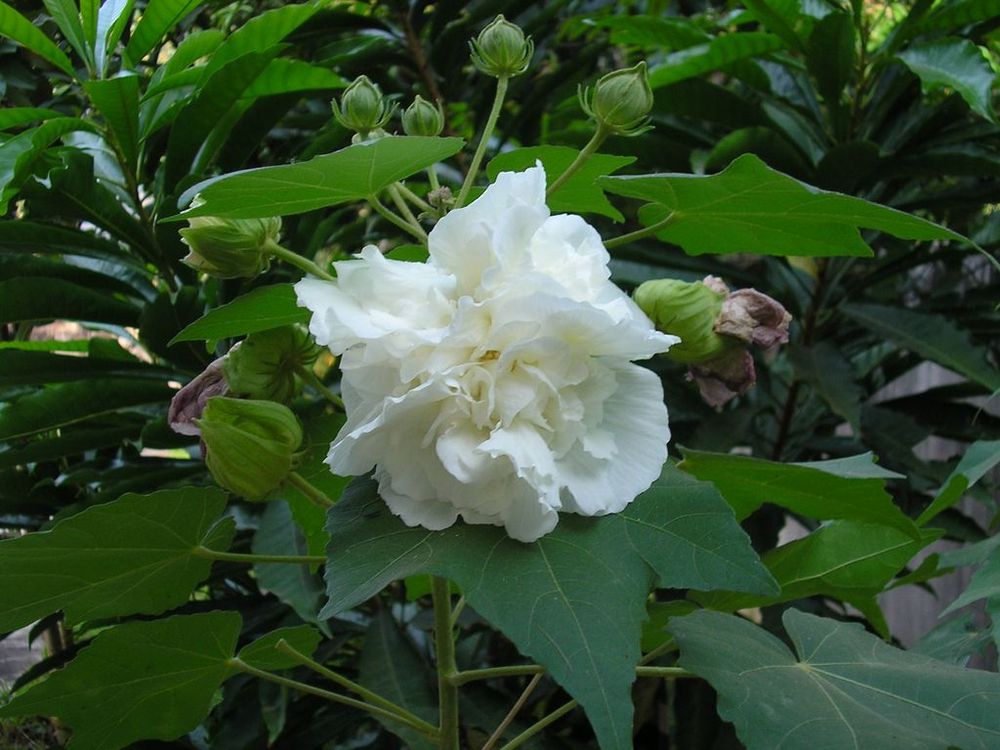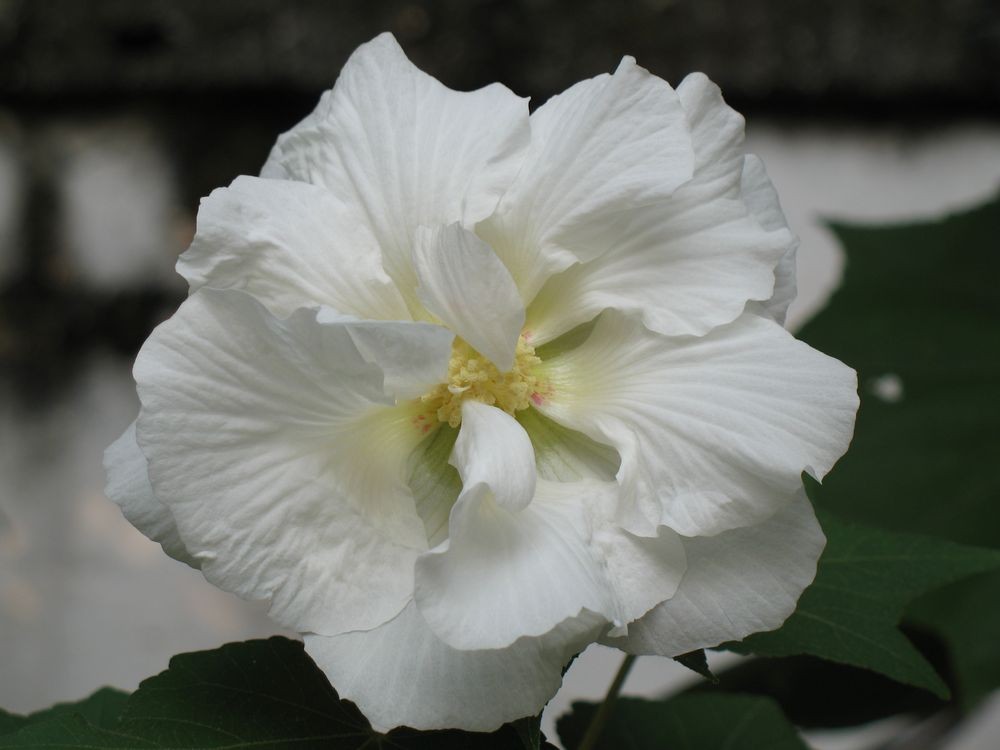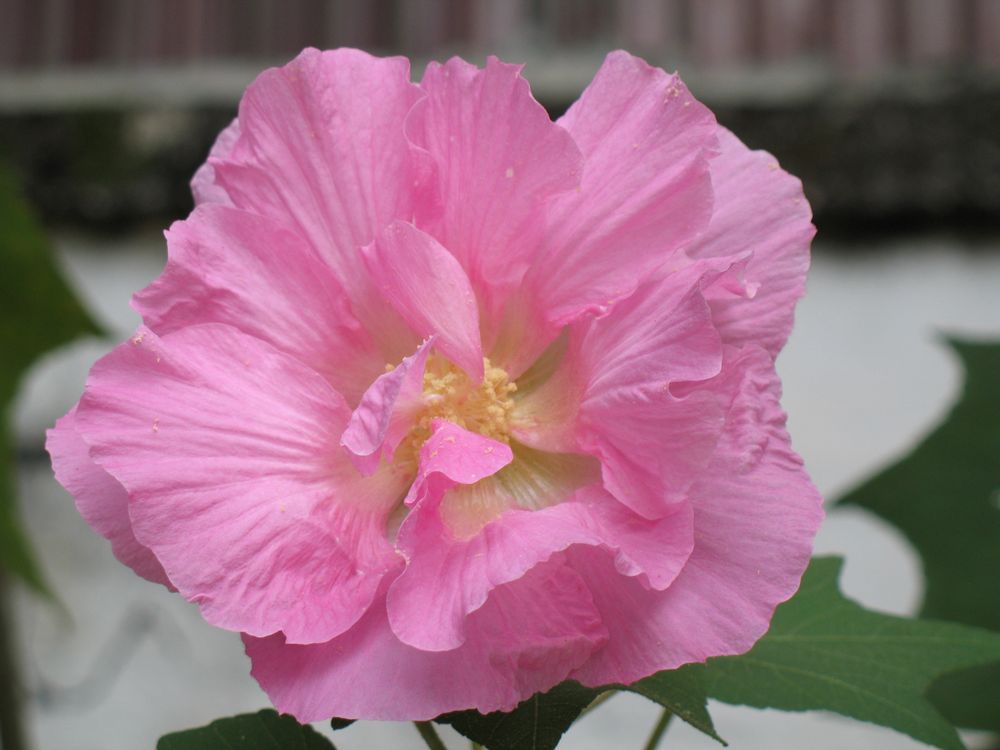For the English and the French, what is striking about this flower from China, 2 to 3 m high, is the fact that it changes colour between the morning when it blooms white and the evening when it closes dark pink. In the French West Indies, moreover, it is called “women’s character”!
However, for the Lao, this shrub is dedicated to Buddha: tone Phout tan. It seems however that, unlike dok Phout, dok Phout tan, is not picked to be offered, because like all hibiscus the flower does not resist cutting, but is mostly reproduced as a decorative motif in pagodas. A Lao friend suggests that Phou tan being the name of Bhutan, in Lao, this flower may have originated there, as well as the Lao people whose Himalayan origin could be considered. This name is also associated with other plant names.
Pour les Anglais et les Français ce qui frappe dans cette fleur originaire de Chine, haute de 2 à 3 m, c’est le fait qu’elle change de couleur entre le matin où elle éclot blanche et le soir où elle se referme rose foncé. Aux Antilles françaises, d’ailleurs, elle est nommée « caractère des femmes » !
Cependant pour les Lao, cet arbuste est dédié à Bouddha: tone Phout tan. Il semble cependant que contrairement à dok Phout, dok Phout tan, ne soit pas cueillie pour être offerte, car comme tous les hibiscus la fleur ne résiste pas à la coupe, mais qu’elle soit surtout reproduite comme motif décoratif dans les pagodes. Une amie lao suggère que Phou tan étant le nom du Bhoutan, en lao, cette fleur en est peut-être originaire, tout comme le peuple lao dont l’origine himalayenne a pu être envisagée. On trouve d’ailleurs ce nom associé à d’autres noms de plante.



For the English and the French, what is striking about this flower from China, 2 to 3 m high, is the fact that it changes colour between the morning when it blooms white and the evening when it closes dark pink. In the French West Indies, moreover, it is called “women’s character”!
However, for the Lao, this shrub is dedicated to Buddha: tone Phout tan. It seems however that, unlike dok Phout, dok Phout tan, is not picked to be offered, because like all hibiscus the flower does not resist cutting, but is mostly reproduced as a decorative motif in pagodas. A Lao friend suggests that Phou tan being the name of Bhutan, in Lao, this flower may have originated there, as well as the Lao people whose Himalayan origin could be considered. This name is also associated with other plant names.
Pour les Anglais et les Français ce qui frappe dans cette fleur originaire de Chine, haute de 2 à 3 m, c’est le fait qu’elle change de couleur entre le matin où elle éclot blanche et le soir où elle se referme rose foncé. Aux Antilles françaises, d’ailleurs, elle est nommée « caractère des femmes » !
Cependant pour les Lao, cet arbuste est dédié à Bouddha: tone Phout tan. Il semble cependant que contrairement à dok Phout, dok Phout tan, ne soit pas cueillie pour être offerte, car comme tous les hibiscus la fleur ne résiste pas à la coupe, mais qu’elle soit surtout reproduite comme motif décoratif dans les pagodes. Une amie lao suggère que Phou tan étant le nom du Bhoutan, en lao, cette fleur en est peut-être originaire, tout comme le peuple lao dont l’origine himalayenne a pu être envisagée. On trouve d’ailleurs ce nom associé à d’autres noms de plante.






For the English and the French, what is striking about this flower from China, 2 to 3 m high, is the fact that it changes colour between the morning when it blooms white and the evening when it closes dark pink. In the French West Indies, moreover, it is called “women’s character”!
However, for the Lao, this shrub is dedicated to Buddha: tone Phout tan. It seems however that, unlike dok Phout, dok Phout tan, is not picked to be offered, because like all hibiscus the flower does not resist cutting, but is mostly reproduced as a decorative motif in pagodas. A Lao friend suggests that Phou tan being the name of Bhutan, in Lao, this flower may have originated there, as well as the Lao people whose Himalayan origin could be considered. This name is also associated with other plant names.
Pour les Anglais et les Français ce qui frappe dans cette fleur originaire de Chine, haute de 2 à 3 m, c’est le fait qu’elle change de couleur entre le matin où elle éclot blanche et le soir où elle se referme rose foncé. Aux Antilles françaises, d’ailleurs, elle est nommée « caractère des femmes » !
Cependant pour les Lao, cet arbuste est dédié à Bouddha: tone Phout tan. Il semble cependant que contrairement à dok Phout, dok Phout tan, ne soit pas cueillie pour être offerte, car comme tous les hibiscus la fleur ne résiste pas à la coupe, mais qu’elle soit surtout reproduite comme motif décoratif dans les pagodes. Une amie lao suggère que Phou tan étant le nom du Bhoutan, en lao, cette fleur en est peut-être originaire, tout comme le peuple lao dont l’origine himalayenne a pu être envisagée. On trouve d’ailleurs ce nom associé à d’autres noms de plante.


